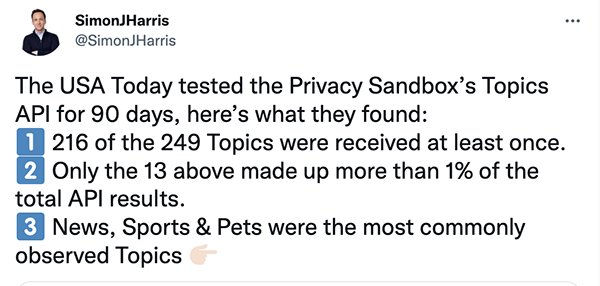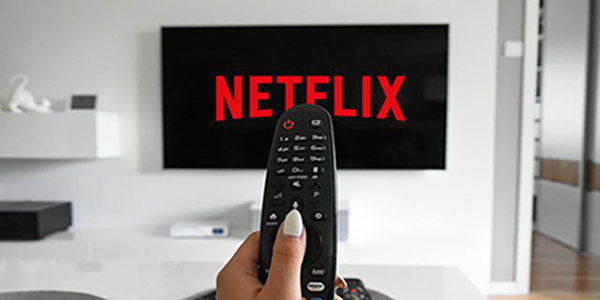 |
||||||||||||
|
||||||||||||
| USA Today Tested Topics API For 90 Days |

Image sourced from Twitter @SimonJHarris
|
| If you've been thinking that Topics API will be the rightful replacement for third-party tracking cookies, you might be left holding your breath if these results we've seen out in the wild from a USA Today 90-day test are any indication of how things are going. "216 of the 249 Topics were received at least once, but only the 13 above made up more than 1% of the total API results. A long tail with a very steep drop," reported Jeff Burkett, VP, Product, Display Media, USA Today. After which he had a whole lot of questions, like if for a single-domain news site, "shouldn't News be 95% of the results if only 5% of results are expected to be random?" Can so many questions be good? Ad Tech Twitter's responses to these results ranged from the data being ostensibly useless to memes about cats. #IYKYK While Burkett stresses that more research will have to be done to figure out whether Topics API will actually work for most major news sites, at first glance he felt strongly that most would have to alter their domain structures to get any real value from Topics. |
| Unless under a rock is where you dwell, then you know all too well that earlier this year Google decided to replace FLOC with Topics API in Chrome as heir to third-party tracking cookies. (Topics API went into public trial starting July 1.) Chrome users will be assigned interest categories based on websites they visit. When users visit a publisher’s site, buyers can access the browser’s interest groups and Chrome will return up to three topics, with one chosen at random. Advertisers can decide if they want to bid on these interests to show ads to users in these categories. But is Topics going to be the right approach? “Industry continues to pretend interest classification targeting or keyword targeting is contextual that works well. Both suck. Interest classification simply too broad & KW misfire often,” shared Judy Shapiro, Founder of Topic Intelligence, in Burkett's Twitter Thread. We've heard Shapiro on Beeler.Cast and What Gets Measured podcasts discussing why it makes sense for buyers to use topic data to drive conversions and acquisitions rather than spraying and praying. And for publishers, the surveillance advertising economy has not adequately rewarded them for their content and audiences they attract to it. Shapiro believes that there's a lot more money for publishers to make once advertisers stop worrying about lower CPMs to reach millions of people and instead focus on the hundreds of thousands of people who are genuinely interested in the topics that are relevant to their brands. If you're agreeing with this line of thinking, then only time will tell if Google's Topics API will benefit both buyer and seller alike. At this moment, from a publisher standpoint, the math is not mathing. |
| Netflix's Slow Roll to Addressability |
 |
| Netflix is the talk of the town these days, and it all began after a Q1 earnings call revealed that the streaming service lost many subscribers and revenue. Since then, they made massive budget cuts along with two rounds of layoffs to shift gears, reinvent their marketing model, and get an ads business going. “There’s a tremendous opportunity to leverage our innovative DNA that we have in enabling characteristics around addressability and measurability to provide an incredible experience for consumers who choose to take the ad-supported offering,” Greg Peters, chief operating officer at Netflix, told investors during Netflix’s Q2 earnings call. “We also [want] to provide an incredible experience for brands and advertisers who want to work with us and [we want to] make sure we’re doing a good job of elevating what that looks like for them.” Ad-supported video-on-demand (AVOD) is on the rise, and the adoption of this model is happening faster than subscription video-on-demand (SVOD), according to a Comscore report from last month. According to a recent Wells Fargo report, experts estimate that with Netflix being an AVOD they should accumulate over 100 million subscribers by 2025. |
| With the ecosystem being all over the place right now, it's time for buyers to consider data-driven tools to provide a quality over quantity ad experience. Don't kill the consumer with a surplus of annoying ads but fewer relevant ones. Netflix has personalization, contextualization, and a fully engaged audience in the bag which provides them with a surplus of data to offer buyers. Plus, let's not forget that Netflix ads will be delivered and sold through Xandr. Keep in mind that Xandr was one of the initial adopters of Unified ID 2.0 (UID2) and buyers are adopting this upgrade to cookies left and right including Publicis Groupe, IPG, and Omnicon Media. Still, building an ad business from the ground up, even with a partner like Microsoft in tow, could prove challenging for the streaming behemoth. When you couple the fact that we could be entering a recession with Netflix's lack of experience in ad sales and building an ad-supported audience, we could be waiting until 2024 before Netflix or their advertising partners realize any real benefits. |
| Advertisers Waste Millions of Ad Spend On Clickbait Sites |
 |
| Nearly 10% of US ad spend is being wasted on junk sites, according to a recent report conducted by Ebiquity. Yes, advertisers are spending a sizable part of their budgets on spammy, low-quality, clickbait sites. The study found that Ebiquity clients spent $115 million between January 2020 and May 2022 on “made for advertising” inventory — clickbait sites that exist merely for siphoning ad budgets. Ebiquity did not disclose the name of their clients, but of course, it raised a few eyebrows when this information came to light. Why do ads end up on “made for advertising” websites? The process appears beneficial to some publishers because they can buy traffic through social media platforms or content-recommendation platforms for less than they make in ad revenue. On the other hand, the cheaper costs nurture a cheaper ad experience. There tends to be high viewability for these sites, but the aesthetic leaves much to be desired and, the CPM is super low. Ruben Schreurs, chief product officer at Ebiquity, asserts that the money set aside for clickbait sites should be used for publications that produce high-quality work. “It’s so blatant, it’s such a big number, we feel it’s a prerogative for brands to make sure that they address this,” says Schreurs. “Exclude this activity and make the effort to understand which properties are misbehaving.” Schruers suggests instead investing in media companies with diverse ownership profiles and relying on exclusion or inclusion lists. |
| Like many cases, going with the cheaper option does not offer a sustainable solution. Using an allotted budget for MFA sites reduces the budget for quality media, thus tainting the standard of the advertisers and publishers. Put simply, using clickbait sites to increase your revenue is wasteful and bad for business. The global chief media officer at UM Worldwide, Joshua Lowcock, backs this claim. According to research done by his media lab, “high-quality content drives better ad performance.” Clickbait sites are also notorious for spreading misinformation. For example, one of the sample advertisers examined in the Ebiquity study was a global pharmaceutical company that supports Covid-19 vaccines. They were found to be funding a website that was spreading anti-vaccine misinformation. Shocking right? However, within the second sample, only $75,000 was spent on diverse media suppliers despite the $750 million available in ad spend. Additionally, this was during a time when advertisers and agencies made public commitments to diversity. Even worse, media analysts see the problem continuing. Predictions say that $12.4 million will be spent on open exchange programmatic in the U.S during 2022. This large budget opens the possibility for marketers to fund low-quality and harmful content without any checks and balances. “It’s a very significant problem,” says Nick Waters, CEO of Ebiquity. “It’s also a very significant opportunity. There is an opportunity to redirect spending from bad actors. There’s also an opportunity cost to not looking at this stuff closely.” As mentioned above, going through inclusion lists is the preferred solution because every domain is vetted and analyzed. This will help to “weed out the bad actors,” as mentioned in the study. This will prevent undesirable environments for ads and ad fraud. “If you let go of the obsession of driving pricing efficiency and you talk about media quality, that resets the expectations,” says Lowcock. “Everyone is driven to the wrong incentive.” Lowcock also asserts that advertisers and publishers should monitor their log files consistently. These files hold detailed records of served impressions and ensure that the media budget is spent as the marketer intended. |
| Around The Water Cooler |
 |
| In other news... The Stop Spreading Disinformation Brigade Wants to Defund Tucker Carlson, Fox News Next: Ad tech watchdog, Check My Ads, has been quite successful in stripping ad dollars from right-wing pundits in the past. Now their sights are on Tucker Carlson and Fox News Digital for spreading conspiracy theories. They recently launched a campaign, enlisting public opinion to help sway ad exchanges from doing further business with Fox News. (Boston Globe) Tremor Acquires Amobee to Connect the dots Across Linear and Digital: Tremor is acquiring ad platform Amobee in a deal that will create scaled connected TV and video end-to-end platforms. (Adweek) Is Social Media Ad Spend Slow Down Further Proof of Recession?: Social media, long the darling of brands far and wide is facing a precipitous drop in ad spend linked to supply-chain disruptions and labor shortages. Recent losses reported by Snapchat and Twitter could signal deeper cuts in overall digital ad spending amid rising interest rates and inflation. Smaller and mid-sized advertisers are going to have an even harder time spending on advertising should a recession hit, especially since their first choice, Meta, has already been so severely impacted by Apple's ATT. (Reuters) |
| @{optoutfooterhtml}@ |









